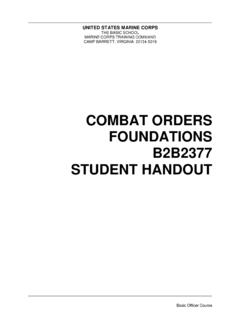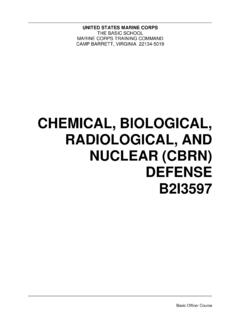Transcription of MILITARY TOPOGRAPHIC MAP I B181936 STUDENT …
1 UNITED STATES MARINE CORPS THE BASIC SCHOOL MARINE CORPS TRAINING COMMAND CAMP BARRETT, VIRGINIA 22134-5019 MILITARY TOPOGRAPHIC MAP I B181936 STUDENT HANDOUT Basic Officer Course B181936 MILITARY TOPOGRAPHIC Map I 2 Basic Officer Course MILITARY TOPOGRAPHIC Map I Introduction The intent of this lesson is to familiarize you with the MILITARY TOPOGRAPHIC map in order to prepare you for follow on classroom and field instruction in land navigation. Maps provide information on the existence and location of man made features such as buildings, bridges, and routes of travel. They also indicate variations in terrain, the elevation of terrain features, and the extent of vegetation. Importance Marine officers must consistently strive for overall situational awareness, including, but not limited to, their and the enemy s current position.
2 This lesson will lay the foundation for ensuring you are skilled in the art of land navigation. In This lesson This lesson discusses how to evaluate and interpret map information, how maps are created and accounted for, and how to neatly and accurately plot grid coordinates on a map. This lesson covers the following topics: Topic Page Material Requirements 4 Marginal Information 5 TOPOGRAPHIC Symbols 7 MILITARY Grid Reference System (MGRS) 7 Graphic Scale and Distance on a Map 9 Requirement 1 Review Questions 12 Requirement 2 Review Questions 14 Requirement 3 Review Questions 15 Requirement 1 Review Answers 16 Requirement 2 Review Answers 17 Requirement 3 Review Answers 18 Summary 19 References 19 Glossary of Terms and Acronyms 19 Notes 19 Learning Objectives Terminal Learning Objective 0300-PAT-1002 Given a MILITARY TOPOGRAPHIC map, protractor and objective, navigate with a map and compass, to arrive within 100 meters of the objective.
3 B181936 MILITARY TOPOGRAPHIC Map I 3 Basic Officer Course MILITARY TOPOGRAPHIC Map I (Continued) Learning Objectives (Continued) Enabling Learning Objectives 0300-PAT-1002a Given a MILITARY TOPOGRAPHIC map, identify marginal information without error. 0300-PAT-1002b Given a MILITARY TOPOGRAPHIC map, identify contour lines without error. 0300-PAT-1002d Given a MILITARY TOPOGRAPHIC map, interpret map colors without error. 0300-PAT-1002e Given a MILITARY TOPOGRAPHIC map, protractor, and a specific point on a map, determine the six- digit grid coordinate to within 100 meters. 0300-PAT-1002f Given a MILITARY TOPOGRAPHIC map, protractor, and two points on a map, determine distance to within 25 meters. MCCS-NAV-2101g Given a MILITARY TOPOGRAPHIC map, protractor, and a specific point on a map, plot the eight-digit grid coordinate to within 50 meters. B181936 MILITARY TOPOGRAPHIC Map I 4 Basic Officer Course Material Requirements For The Basic School land navigation package, you will require the following maps and materials.
4 Maps Quantico 1:50,000 Special. New River V742 5553 III. Margarita Peak V795 2550 IV. Mapping Gear Straight edge with map scale markings. Protractor. Lead pencils and black ball point pens. Fine tip mapping pens. Pencil sharpener. Eraser (pencil and alcohol pen). Whistle. Waterproof bag Ziploc bag, etc. Lamination Laminate your 1:50,000 Quantico land navigation special map sheet. We highly recommend that you laminate the map either at the Lamination Station at the Marine Corps Exchange on board Camp Barrett or at The Scholarship in Aquia Towne Centre. Do not laminate the map at Staples, as their lamination is very thick and is not conducive to folding. When preparing your map for lamination, Trim and SAVE the marginal information. Tape/paste the marginal information to the back of your map BEFORE you laminate the map. B181936 MILITARY TOPOGRAPHIC Map I 5 Basic Officer Course Marginal Information Use marginal information for: Identification indicates which area coverage the map represents.
5 Interpretation provides correlation between actual terrain features and map TOPOGRAPHIC symbols. Evaluation helps determine the validity of the information represented on the map. The elements contained in marginal information are listed below with a brief description. Refer to the diagram on page 6 to see where the elements appear on a map as indicated by the number in parentheses after the name of each element. Sheet Name (1) The sheet name describes the most significant terrain feature covered by a particular map (cities, mountains, etc.) Series and Sheet Number (2 and 5) Numbers are provided for organization and accounting purposes. The sheet number refers to a specific map; a series contains numerous sheets. Series Name (3) A collection of maps representing a specific geographical area has a series name. Scale (4) The scale is a ratio of map to real-world coverage; depicted using a colon or a comma, as in 1:50,000.
6 Edition Number (6) The edition number is the production version number; a high number indicates a more recent map. Sources are Defense Mapping Agency (DMA) or National Imagery Mapping Agency (NIMA). Index to Adjoining Sheets and Boundaries (7 and 8) The index displays sheet and series numbers for maps that cover areas adjacent to those covered by a particular map and the political boundaries of an area. Elevation Guide (9) The elevation guide gives a general overview of the elevation of the terrain covered by the map. Declination Diagram (10) The declination diagram provides a reference showing declinations of grid North and magnetic North from true North. Bar Scales (11) The bar scales show straight line distances in kilometers, statute miles, and nautical miles. B181936 MILITARY TOPOGRAPHIC Map I 6 Basic Officer Course Marginal Information (Continued) Contour Interval Note (12) The contour interval note describes the elevation change between consecutive contour lines: Horizontal datum indicates the collection of data from which the grid reference system is based.
7 ALWAYS CHECK THE HORIZONTAL DATUM! Vertical datum indicates the collection of data from which the elevation data is based. Legend (13) The legend provides the key for interpreting the map symbols. Grid Reference Box (14) The grid reference box provides information indicating the 100,000 meter grid square identifier and grid zone designator for a particular map, as well as information on plotting specific points to an accuracy of 100 meters. Stock Number (15) Use the stock number to reorder maps from NIMA. B181936 MILITARY TOPOGRAPHIC Map I 7 Basic Officer Course TOPOGRAPHIC Symbols TOPOGRAPHIC symbols are symbols used on a map to represent actual terrain features. Colors Colors represent different terrain features. The colors that may be used on a map are: Black: manmade features. Brown: terrain features.* Green: vegetation. Blue: water. Red: road conditions and built-up areas.
8 * *Note: Recent maps show only four colors. In 1982, brown and red colors were combined to make MILITARY maps red-light readable. Likewise, the features these colors represent are also combined, , red/brown represents terrain features, roads, and built-up areas. MILITARY Grid Reference System The MILITARY Grid Reference System (MGRS) is the geographic standard used by the United States armed forces and NATO for locating any point on the earth with a 2 to 10 character geocode. A two digit code implies a precision of 10 km; a ten digit code corresponds to a 1 m precision with intermediate steps of 1 km, 100 m, and 10 m. The geocode is always displayed in an even number of characters preceded by an alpha- numeric code describing the larger Earth area to which it belongs. B181936 MILITARY TOPOGRAPHIC Map I 8 Basic Officer Course MILITARY Grid Reference System (Continued) How to Plot/Read MGRS Coordinates Be neat and accurate with all map work!
9 All information required to correctly read/plot a grid coordinate is in the marginal information! To plot MGRS coordinates, Identify the correct grid square. Correctly orient your protractor on the grid square. RIGHT THEN UP. Read MGRS coordinates, for example, 18S TT 8750 6380 (Camp Barrett) as follows: 18S: Grid zone designation: 6 degrees x 8 degrees TT: 100,000 meter grid square 875 638: 6 digit grid = 100m accuracy 8750 6380: 8 digit grid = 10m accuracy 87500 63800: 10 digit grid = 1m accuracy Protractor Be sure to use the correct scale when plotting/ reading grid coordinates and to correctly orient your protractor (see diagram below) with respect to the map. B181936 MILITARY TOPOGRAPHIC Map I 9 Basic Officer Course MILITARY Grid Reference System (Continued) Partial Grid Squares If a plotted point lies within a partial grid square, you have to reconstruct the grid square in order to accurately plot or read an eight-digit grid coordinate (see diagram below).
10 The table below lists the steps for reconstructing the grid square to accurately plot or read an eight-digit grid coordinate. Step Action 1 Using the coordinate scale on your protractor, draw in the incomplete sides of the grid square out to 1000 meters for each side. You will have to rotate the coordinate scale for each side to accomplish this step. 2 Utilize the same technique for reading or plotting an eight-digit grid coordinate on a complete grid square to read or plot your eight-digit grid coordinate. Graphic Scale and Distance on a Map Maps are categorized by their scale: Large scale: 1:75,000 and larger. Medium scale: Smaller than 1:75,000 and larger than 1:600,000. Small scale: 1:600,000 and smaller. Small unit leaders primarily utilize large-scale maps and some medium scale maps. B181936 MILITARY TOPOGRAPHIC Map I 10 Basic Officer Course Graphic Scale and Distance on a Map (Continued) Large Scale Maps Large scale maps Cover relatively small area.





